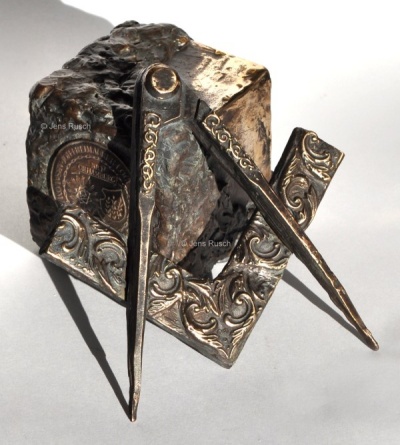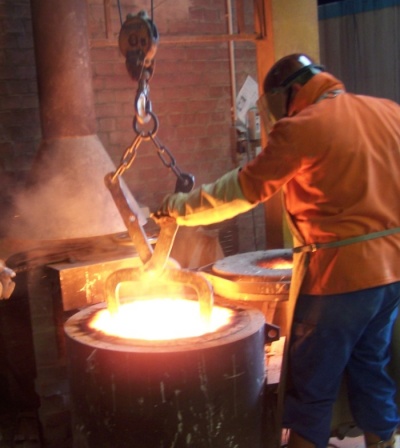En:Workshop Royal Art: Unterschied zwischen den Versionen
Keine Bearbeitungszusammenfassung |
Keine Bearbeitungszusammenfassung |
||
| Zeile 1: | Zeile 1: | ||
[[Datei:Bronze1hellerHG.jpg|thumb|400px|This bronze was created by Br Jens Rusch as a reminiscence of the founding fathers of German Freemasonry at the occasion of the 275th anniversary of the founding of the first German Masonic lodge in Hamburg.]] | [[Datei:Bronze1hellerHG.jpg|thumb|400px|This bronze was created by Br Jens Rusch as a reminiscence of the founding fathers of German Freemasonry at the occasion of the 275th anniversary of the founding of the first German Masonic lodge in Hamburg.]] | ||
[[Datei:Bronze Detail.jpg|thumb|left|350px]] | [[Datei:Bronze Detail.jpg|thumb|left|350px]] | ||
| Zeile 21: | Zeile 20: | ||
[[Datei:Rauhe Bronze.jpg|thumb|400px|Finally , there is a rough stone, all cast in bronze, in front of us. The height is now 14 cm and the diagonal to the tip of the compass 19 cm. The ornate symbolism takes us back a bit into the origins of German Freemasonry.]] | [[Datei:Rauhe Bronze.jpg|thumb|400px|Finally , there is a rough stone, all cast in bronze, in front of us. The height is now 14 cm and the diagonal to the tip of the compass 19 cm. The ornate symbolism takes us back a bit into the origins of German Freemasonry.]] | ||
== "Vanitas vanitatum" == | |||
Vanitas themes were common in medieval funerary art, with most surviving examples in sculpture. By the 15th century these could be extremely morbid and explicit, reflecting an increased obsession with death and decay also seen in the Ars moriendi, Danse Macabre, and the overlapping motif of the Memento mori. From the Renaissance such motifs gradually became more indirect, and as the still-life genre became popular, found a home there. Paintings executed in the vanitas style were meant to remind viewers of the transience of life, the futility of pleasure, and the certainty of death. They also provided a moral justification for many paintings of attractive objects. | |||
Common vanitas symbols include skulls, which are a reminder of the certainty of death; rotten fruit, which symbolizes decay; bubbles, which symbolize the brevity of life and suddenness of death; smoke, watches, and hourglasses, which symbolize the brevity of life; and musical instruments, which symbolize brevity and the ephemeral nature of life. Fruit, flowers and butterflies can be interpreted in the same way, and a peeled lemon, as well as accompanying seafood was, like life, attractive to look at, but bitter to taste. There is debate among art historians as to how much, and how seriously, the vanitas theme is implied in still-life paintings without explicit imagery such as a skull. As in much moralistic genre painting, the enjoyment evoked by the sensuous depiction of the subject is in a certain conflict with the moralistic message. | |||
== Number of copies == | == Number of copies == | ||
The engraved numbering will be provided after receipt of order. Favourite numbers can be engraved only in exceptional cases. Each copy signed by the artist. Engraved dedications to customer's requirements at no extra cost. | The engraved numbering will be provided after receipt of order. Favourite numbers can be engraved only in exceptional cases. Each copy signed by the artist. Engraved dedications to customer's requirements at no extra cost. | ||
Version vom 28. Mai 2012, 15:40 Uhr
Workshop "Royal Art"
Thanks for translation to Bro Edward Schmidt-Zeuner
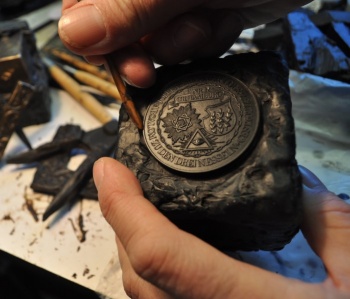
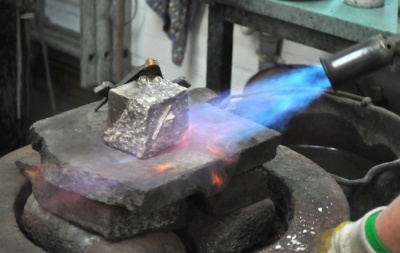
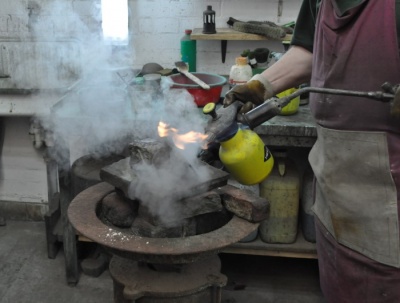
"Vanitas vanitatum"
Vanitas themes were common in medieval funerary art, with most surviving examples in sculpture. By the 15th century these could be extremely morbid and explicit, reflecting an increased obsession with death and decay also seen in the Ars moriendi, Danse Macabre, and the overlapping motif of the Memento mori. From the Renaissance such motifs gradually became more indirect, and as the still-life genre became popular, found a home there. Paintings executed in the vanitas style were meant to remind viewers of the transience of life, the futility of pleasure, and the certainty of death. They also provided a moral justification for many paintings of attractive objects.
Common vanitas symbols include skulls, which are a reminder of the certainty of death; rotten fruit, which symbolizes decay; bubbles, which symbolize the brevity of life and suddenness of death; smoke, watches, and hourglasses, which symbolize the brevity of life; and musical instruments, which symbolize brevity and the ephemeral nature of life. Fruit, flowers and butterflies can be interpreted in the same way, and a peeled lemon, as well as accompanying seafood was, like life, attractive to look at, but bitter to taste. There is debate among art historians as to how much, and how seriously, the vanitas theme is implied in still-life paintings without explicit imagery such as a skull. As in much moralistic genre painting, the enjoyment evoked by the sensuous depiction of the subject is in a certain conflict with the moralistic message.
Number of copies
The engraved numbering will be provided after receipt of order. Favourite numbers can be engraved only in exceptional cases. Each copy signed by the artist. Engraved dedications to customer's requirements at no extra cost.
Delivery time
The cast will be commissioned only after receipt of order. The delivery time is entirely dependent on the order situation of the bronze foundry. It is therefore advisable to anticipate a longer delivery time.

